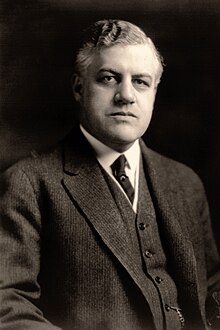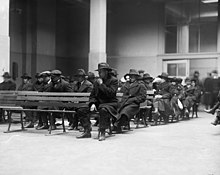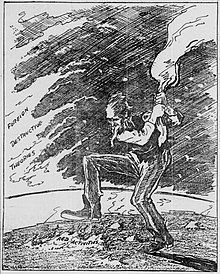Palmer Raids

ThePalmer Raidswere a series of raids conducted in November 1919 and January 1920 by theUnited States Department of Justiceunder the administration of PresidentWoodrow Wilsonto capture and arrest suspectedsocialists,especiallyanarchistsandcommunists,anddeportthem from the United States. The raids particularly targetedItalian immigrantsand Eastern EuropeanJewish immigrantswith allegedleftistties, with particular focus onItalian anarchistsand immigrant leftistlabor activists.The raids and arrests occurred under the leadership of Attorney GeneralA. Mitchell Palmer,with 6,000 people arrested across 36 cities. Though 556 foreign citizens were deported, including a number of prominent leftist leaders, Palmer's efforts were largely frustrated by officials at theU.S. Department of Labor,which had authority for deportations and objected to Palmer's methods.
The Palmer Raids occurred in the larger context of theFirst Red Scare,a period of fear of and reaction against communists in the U.S. in the years immediately followingWorld War Iand theRussian Revolution.[1]There were strikes that garnered national attention, and promptedrace riotsin more than 30 cities, as well astwo sets of bombingsin April and June 1919, including one bomb mailed to Palmer's home.
Background[edit]
During theFirst World Warthere was a nationwide campaign in the United States against the real and imagined divided political loyalties of immigrants and ethnic groups, who were feared to have too much loyalty for their nations of origin. In 1915,President Wilsonwarned againsthyphenated Americanswho, he charged, had "poured the poison of disloyalty into the very arteries of our national life." "Such creatures of passion, disloyalty and anarchy", Wilson continued, "must be crushed out".[2]TheRussian Revolutions of 1917added special force to fear of labor agitators and partisans of ideologies like anarchism and communism. Thegeneral strike in Seattlein February 1919 represented a new development in labor unrest.[3]
The fears of Wilson and other government officials were confirmed whenGalleanists—Italian immigrant followers of the anarchistLuigi Galleani—carried out a series ofbombings in April and June 1919.[4]At the end of April, some 30 Galleanistletter bombshad been mailed to a host of individuals, mostly prominent government officials and businessmen, but also law enforcement officials.[4]Only a few reached their targets, and not all exploded when opened. Some people suffered injuries, including a housekeeper in SenatorThomas W. Hardwick's residence, who had her hands blown off.[4]On June 2, 1919, the second wave of bombings occurred, when several much larger package bombs were detonated by Galleanists in eight American cities, including one that damaged the home of Attorney GeneralA. Mitchell Palmerin Washington, D.C.[4]At least one person was killed in this second attack, night watchman William Boehner, and fears were raised because it occurred in the capital.[4][5][6]Flyersdeclaring war on capitalists in the name of anarchist principles accompanied each bomb.[4]
Preparations[edit]
| Part ofa serieson |
| Anarchism |
|---|
 |
In June 1919, Attorney General Palmer told theHouse Appropriations Committeethat all evidence promised that radicals would "on a certain day...rise up and destroy the government at one fell swoop." He requested an increase in his budget to $2,000,000 from $1,500,000 to support his investigations of radicals, but Congress limited the increase to $100,000.[7]
An initial raid in July 1919 against an anarchist group inBuffalo,New York, achieved little when a federal judge tossed out Palmer's case. He found in the case that the three arrested radicals, charged under a law dating from theCivil War,had proposed transforming the government by using theirfree speechrights and not by violence.[8]That taught Palmer that he needed to exploit the more powerful immigration statutes that authorized the deportation ofalienanarchists, violent or not. To do that, he needed to enlist the cooperation of officials at the Department of Labor. Only the Secretary of Labor could issue warrants for the arrest of alien violators of the Immigration Acts, and only he could sign deportation orders following a hearing by an immigration inspector.[9]
On August 1, 1919, Palmer named 24-year-oldJ. Edgar Hooverto head a new division of the Justice Department'sBureau of Investigation,theGeneral Intelligence Division(GID), with responsibility for investigating the programs of radical groups and identifying their members.[10]TheBoston Police Strikein early September raised concerns about possible threats to political and social stability. On October 17, the Senate passed a unanimous resolution demanding Palmer explain what actions he had or had not taken against radical aliens and why.[11]
At 9 pm on November 7, 1919, a date chosen because it was the second anniversary of theBolshevikrevolution, agents of the Bureau of Investigation, together with local police, executed a series of well-publicized and violent raids against theUnion of Russian Workersin 12 cities. Newspaper accounts reported some were "badly beaten" during the arrests. Many later swore they were threatened and beaten during questioning. Government agents cast a wide net, bringing in some American citizens, passers-by who admitted being Russian, some not members of the Russian Workers. Others were teachers conducting night school classes in space shared with the targeted radical group. Arrests far exceeded the number of warrants. Of 650 arrested in New York City, the government managed to deport just 43.[12]
When Palmer replied to the Senate's questions of October 17, he reported that his department had amassed 60,000 names with great effort. Required by the statutes to work through the Department of Labor, they had arrested 250 dangerous radicals in the November 7 raids. He proposed a new Anti-Sedition Law to enhance his authority to prosecute anarchists.[13]
Raids and arrests in January 1920[edit]


As Attorney General Palmer struggled with exhaustion and devoted all his energies to theUnited Mine Workerscoal strike in November and December 1919,[14]Hoover organized the next raids. He successfully persuaded the Department of Labor to ease its insistence on promptly alerting those arrested of their right to an attorney. Instead, Labor issued instructions that its representatives could wait until after the case against the defendant was established, "in order to protect government interests."[15]Less openly, Hoover decided to interpret Labor's agreement to act against the Communist Party to include a different organization, theCommunist Labor Party.Finally, despite the fact that Secretary of LaborWilliam B. Wilsoninsisted that more than membership in an organization was required for a warrant, Hoover worked with more compliant Labor officials and overwhelmed Labor staff to get the warrants he wanted. Justice Department officials, including Palmer and Hoover, later claimed ignorance of such details.[16]
The Justice Department launched a series of raids on January 2, 1920, with follow up operations over the next few days. Smaller raids extended over the next 6 weeks. At least 3000 were arrested, and many others were held for various lengths of time. The entire enterprise replicated the November action on a larger scale, including arrests and seizures without search warrants, as well as detention in overcrowded and unsanitary holding facilities. Hoover later admitted "clear cases of brutality."[17]The raids covered more than 30 cities and towns in 23 states, but those west of the Mississippi and south of the Ohio were "publicity gestures" designed to make the effort appear nationwide in scope.[18]Because the raids targeted entire organizations, agents arrested everyone found in organization meeting halls, not only arresting non-radical organization members but also visitors who did not belong to a target organization, and sometimes American citizens not eligible for arrest and deportation.[19]
The Department of Justice at one point claimed to have taken possession of several bombs, but after a few iron balls were displayed to the press they were never mentioned again. All the raids netted a total of just four ordinary pistols.[20]
While most press coverage continued to be positive, with criticism only from leftist publications likeThe NationandThe New Republic,one attorney raised the first noteworthy protest. Francis Fisher Kane, the U.S. Attorney for the Eastern District ofPennsylvania,resigned in protest. In his letter of resignation to the President and the Attorney General he wrote: "It seems to me that the policy of raids against large numbers of individuals is generally unwise and very apt to result in injustice. People not really guilty are likely to be arrested and railroaded through their hearings...We appear to be attempting to repress a political party...By such methods, we drive underground and make dangerous what was not dangerous before." Palmer replied that he could not use individual arrests to treat an "epidemic" and asserted his own fidelity to constitutional principles. He added: "The Government should encourage free political thinking and political action, but it certainly has the right for its own preservation to discourage and prevent the use of force and violence to accomplish that which ought to be accomplished, if at all, by parliamentary or political methods."[21]The Washington Postendorsed Palmer's claim for urgency over legal process: "There is no time to waste on hairsplitting over infringement of liberty."[22]
Aftermath[edit]
In a few weeks, after changes in personnel at the Department of Labor, Palmer faced a new and very independent-minded Acting Secretary of Labor in Assistant Secretary of LaborLouis Freeland Post,who canceled more than 2,000 warrants as being illegal.[23]Of the 10,000 arrested, 3,500 were held by authorities in detention; 556 resident aliens were eventually deported under theImmigration Act of 1918.[24]
At a Cabinet meeting in April 1920, Palmer called on Secretary of LaborWilliam B. Wilsonto fire Post, but Wilson defended him. The President listened to his feuding department heads and offered no comment about Post, but he ended the meeting by telling Palmer that he should "not let this country see red." Secretary of the NavyJosephus Daniels,who made notes of the conversation, thought the Attorney General had merited the President's "admonition", because Palmer "was seeing red behind every bush and every demand for an increase in wages."[25]
Palmer's supporters in Congress responded with an attempt toimpeachLouis Post or, failing that, tocensurehim. The drive against Post began to lose energy when Attorney General Palmer's forecast of an attempted radical uprising onMay Day1920 failed to occur. Then, in testimony before the House Rules Committee on May 7–8, Post proved "a convincing speaker with a caustic tongue"[23]and defended himself so successfully that CongressmanEdward W. Pou,a Democrat presumed to be an enthusiastic supporter of Palmer, congratulated him: "I feel that you have followed your sense of duty absolutely."[26]
On May 28, 1920, the nascentAmerican Civil Liberties Union(ACLU), which was founded in response to the raids,[27]published itsReport Upon the Illegal Practices of the United States Department of Justice,[28]which carefully documented unlawful activities in arresting suspected radicals, illegal entrapment byagents provocateur,and unlawful incommunicado detention. Such prominent lawyers and law professors asFelix Frankfurter,Roscoe PoundandErnst Freundsigned it. Harvard ProfessorZechariah Chafeecriticized the raids and attempts at deportations and the lack of legal process in his 1920 volumeFreedom of Speech.He wrote: "That aQuakershould employ prison and exile to counteract evil-thinking is one of the saddest ironies of our time. "[29] The Rules Committee gave Palmer a hearing in June, where he attacked Post and other critics whose "tender solicitude for social revolution and perverted sympathy for the criminal anarchists...set at large among the people the very public enemies whom it was the desire and intention of the Congress to be rid of." The press saw the dispute as evidence of the Wilson administration's ineffectiveness and division as it approached its final months.[30]
In June 1920, a decision by Massachusetts District Court JudgeGeorge W. Andersonordered the discharge of 17 arrested aliens and denounced the Department of Justice's actions. He wrote that "a mob is a mob, whether made up of Government officials acting under instructions from the Department of Justice, or of criminals and loafers and the vicious classes." His decision effectively prevented any renewal of the raids.[31]
Palmer, once seen as a likelypresidentialcandidate, lost his bid to win theDemocraticnomination for president later in the year.[32]The anarchist bombing campaign continued intermittently for another twelve years.[33]
See also[edit]
- Espionage Act of 1917
- Industrial Workers of the World
- McCarthyism
- 1918-1920 New York City rent strikes
References[edit]
- ^"Palmer Raids".16 March 2023.
- ^Kennedy, 24
- ^Shepley, Nick (2015).The Palmer Raids and the Red Scare: 1918–1920: Justice and Liberty for All.Andrews UK Limited. pp. 18–19.ISBN978-1-84989-944-4.
- ^abcdefAvrich, Paul,Sacco and Vanzetti: The Anarchist Background,Princeton University Press,ISBN0-691-02604-1(1991), pp. 140–143, 147, 149–156
- ^"Plotter Here Hid Trail Skillfully; His victim Was a Night Watchman; Police Study Anarchistic Handbills Adroitly Placed by the Conspirator-Expert Declares Bomb Held Twenty-fivePounds of Dynamite. Thinks Bomb Contained Dynamite. Windows All About Shattered. PLOTTER HERE HID TRAIL SKILFULLY Handbills Studied by Police. Hylan Consults Enright".The New York Times.4 June 1919.
- ^"WRECK JUDGE NOTT'S HOME; Man and Woman Killed May Have Been Bomb Setters. MRS. NOTT IN THE HOUSE She and Caretaker's Family Escape, Though Front of Building Was Shattered. JUDGE NOTT IN THE COUNTRY Police Rush Guards to Homes of Officials and Judges Throughout the City. Child's Amazing Escape. Stairways Fall. Other Houses Shattered. WRECK JUDGE NOTT'S HOME. All Police Agencies Active. Crowds Hamper Police. Judge Nott's Public Career".The New York Times.3 June 1919.
- ^Hagedorn, 229–30; Coben, 211
- ^Pietruszka, 146–7
- ^Coben 217–8
- ^Coben, 207–9
- ^Coben, 214–5
- ^Coben, 219–21; Post, 28–35. Post says 11 cities.
- ^"PALMER FOR STRINGENT LAW; Attorney General Asks Senate for Sedition Act to Fit Reds. NEW PUNISHMENT PLAN He Would Send All Aliens from Country and Denaturalize Convicted Citizens. TELLS OF REDS' ACTIVITIES Work of Union of Russians Revealed--472 PublicationsPreaching Anarchy. The Attorney General's Letter. PALMER FOR STRINGENT LAW Penal Code Test Case. Where the Laws Are Weak. Difficulties of Deportation. Many" Red "Publications. Radical Papers Increase. Proposed Anti-Sedition Law. ASKS FOR IRON-CLAD LAWS. Mayor of Portland Appeals to Senate for Immediate Legislation".The New York Times.16 November 1919.
- ^"Miners Finally Agree"(PDF).The New York Times.December 11, 1919.Archived(PDF)from the original on 2022-10-09.RetrievedJune 11,2014.
- ^Coben, 222–3
- ^Murray, 223–7
- ^Murray, 227–9
- ^States (cities where available): California (Los Angeles,San Francisco), Colorado (Denver), Connecticut (Ansonia,Bridgeport,Hartford,Meriden,New Haven,New London,South Manchester,Waterbury), Florida, Illinois (Chicago,Rockford,East St. Louis), Indiana, Iowa (Des Moines), Kansas (Kansas City), Maine, Maryland, Massachusetts (Boston,Chelsea,Brockton,Bridgewater,Norwood,Worcester,Springfield,Chicopee Falls,Holyoke,Gardner,Fitchburg,Lowell,Lawrence,Haverhill), Michigan (Detroit), Minnesota (St. Paul), Nebraska (Omaha), New Hampshire (Claremont,Derry,Lincoln,Manchester,Nashua,Portsmouth), New Jersey (Camden), New York (Buffaloand "nearby towns",New York City), Ohio (Cleveland,Toledo,Youngstown), Oregon (Portland), Pennsylvania (Chester,Pittsburgh), Washington (Spokane), Wisconsin (Milwaukee,Racine). Others were arrested in West Virginia by agents working from Pittsburgh. Post, 91–2, 96, 104–5, 108, 110, 115–6, 120–1, 124, 126, 131
- ^Post, 96–147,passim
- ^Post, 91–5, 96–147
- ^Coben, 230;The New York Times:"Palmer Upholds Red Repression," January 24, 1920,accessed January 15, 2010,
- ^The Washington Post,"The Red Assassins," January 4, 1920
- ^abCoben, 232
- ^Avakov, Aleksandr Vladimirovich,Plato's Dreams Realized: Surveillance and Citizen Rights from KGB to FBI,Algora Publishing,ISBN0-87586-495-3,ISBN978-0-87586-495-2(2007), p. 36
- ^Daniels, 545–6
- ^Post, 273
- ^"ACLU History".
- ^Report Upon the Illegal Practices of the United States Department of Justice.National Popular Government League. 1920.
- ^Chafee, 197, ch. 5 "Deportations"
- ^Murray, 255–6
- ^Murray, 250–1; Post, 97
- ^Pietrusza, 257
- ^Avrich, 214
General bibliography[edit]
- Avrich, Paul,Sacco and Vanzetti: The Anarchist Background(Princeton University Press, 1991)
- Chafee, Zechariah,Freedom of Speech(New York: Harcourt, Brace, and Howe, 1920)
- Coben, Stanley,A. Mitchell Palmer: Politician(New York: Columbia University Press, 1963)
- Daniels, Josephus,The Wilson Era: Years of War and After, 1917–1923(Chapel Hill: University of North Carolina Press, 1946)
- Dunn, Robert W.The Palmer Raids.New York: International Publishers. 1948.
- Finan, Christopher M. (2007).From the Palmer Raids to the Patriot Act: A History of the Fight for Free Speech in America.Beacon Press.ISBN978-0-8070-4428-5.
- Hagedorn, Ann,Savage Peace: Hope and Fear in America, 1919(New York: Simon & Schuster, 2007)
- Kennedy, David M.,Over Here: The First World War and American Society(New York: Oxford University Press, 1980)
- Murray, Robert K.,Red Scare: A Study in National Hysteria, 1919–1920(Minneapolis: University of Minnesota Press, 1955)
- Pietrusza, David,1920: The Year of Six presidents(New York: Carroll & Graf, 2007)
- Post, Louis F.,The Deportations Delirium of Nineteen-twenty: A Personal Narrative of a Historic Official Experience(New York, 1923), reissued:ISBN0-306-71882-0,ISBN1-4102-0553-3
- Shepley, Nick (2015).The Palmer Raids and the Red Scare: 1918-1920: Justice and Liberty for All.Andrews UK Limited.ISBN978-1-84989-945-1.
Further reading[edit]
- Pusey, Allen (2015)."Palmer Raids Target Immigrants".ABA Journal.101:100.
- Popkova, Anna (2 January 2022). "Imagining the Russian Community: Novoye Russkoe Slovo, the First Red Scare, and the Palmer Raids, 1919-1920".Journalism History.48(1): 41–60.doi:10.1080/00947679.2022.2027140.S2CID246293091.
- Cohen, Harlan Grant (2003)."The (Un)favorable Judgment of History: Deportation Hearings, the Palmer Raids, and the Meaning of History"(PDF).New York University Law Review.78:1431.
External links[edit]
 Media related toPalmer Raidsat Wikimedia Commons
Media related toPalmer Raidsat Wikimedia Commons
- Anti-anarchism in the United States
- Anti-communism in the United States
- Anti-Italian sentiment
- Antisemitism in the United States
- Civil detention in the United States
- History of the Industrial Workers of the World
- Industrial Workers of the World in the United States
- Italian-American history
- Political and cultural purges
- Political repression in the United States
- Presidency of Woodrow Wilson
- November 1919 events in the United States
- December 1919 events
- January 1920 events
- Red Scare
- Law enforcement operations in the United States
- United States Department of Justice
- Reactions to the Russian Revolution and Civil War
